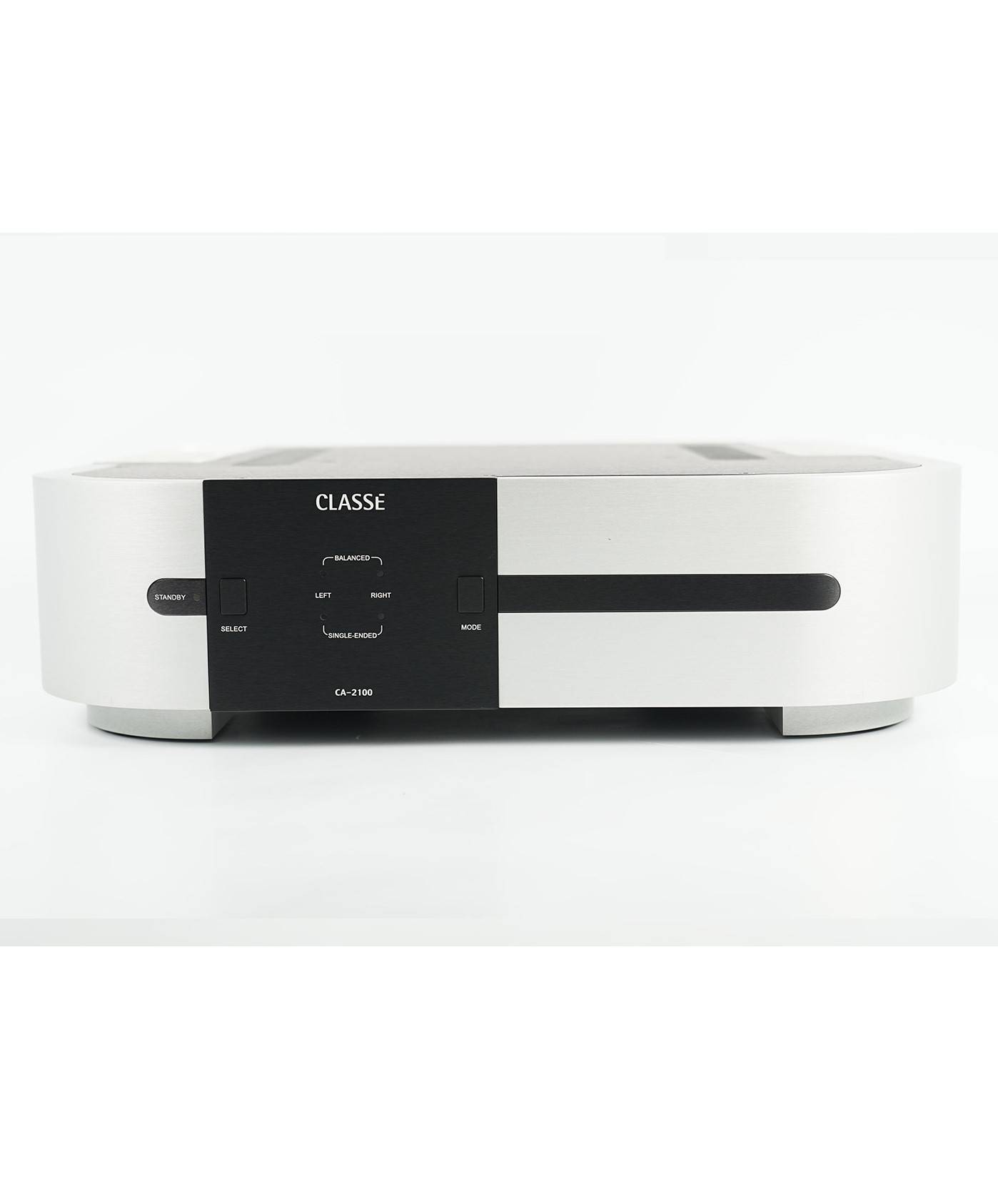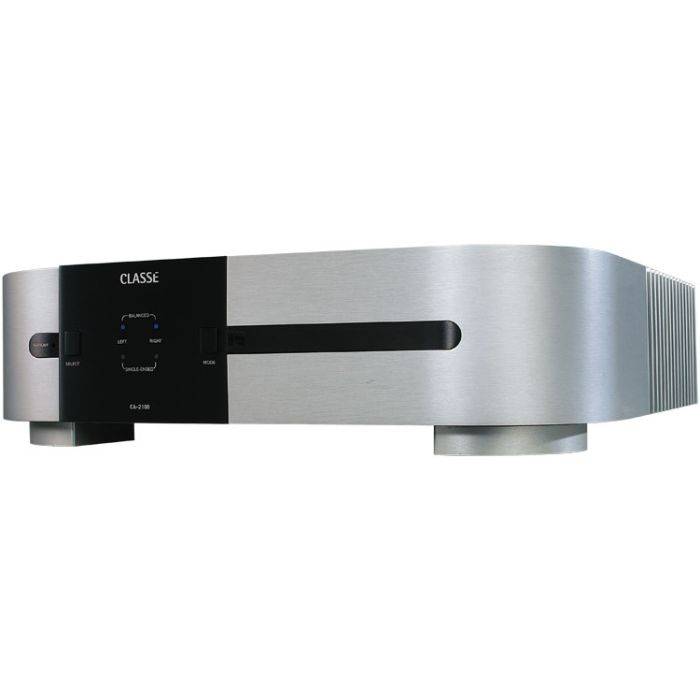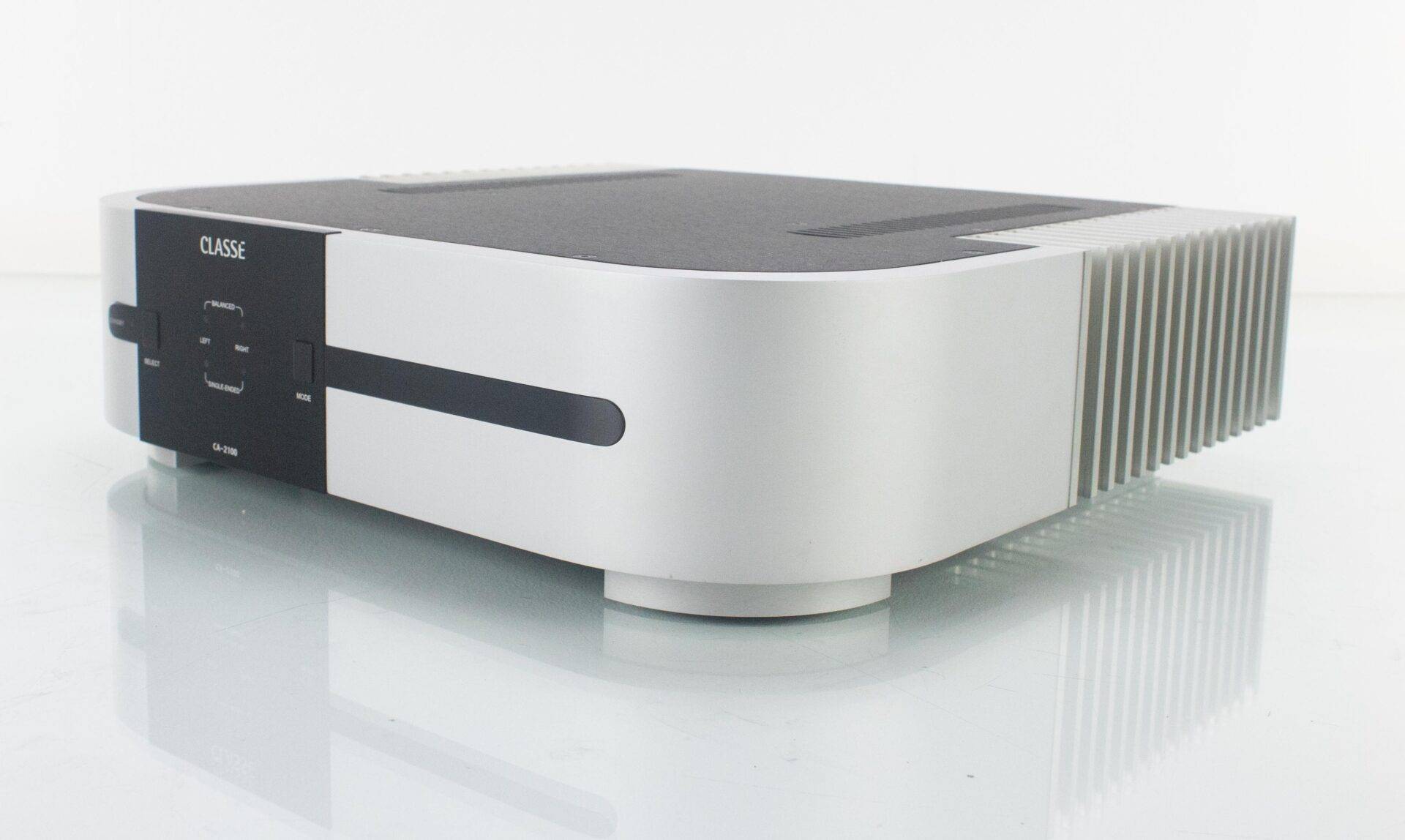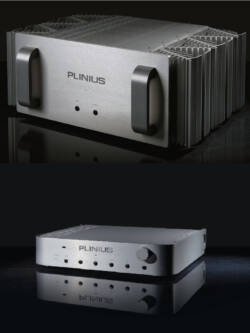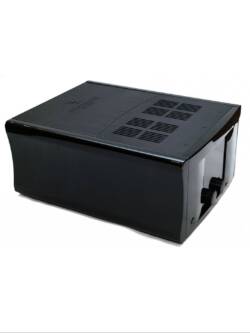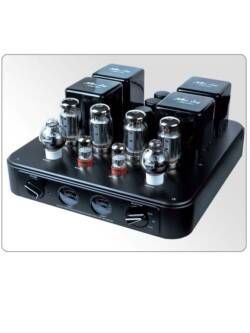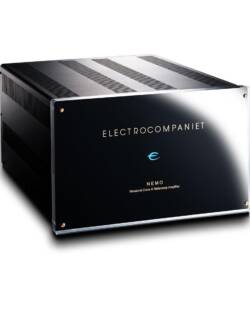Classe CA-2100 Stereo Amplifier
Original price was: R128,000.00.R32,000.00Current price is: R32,000.00.
Classé Audio CA-2100 Power Amplifier Review
• Power/channel (continuous): 100W (8 ohms), 200W (4 ohms)
• Voltage gain: 29.1dB
• Bandwidth:155kHz (-3dB), 22kHz (-0.1dB), phase < -10° (22kHz)
• Sensitivity: 1.0Vrms
• THD + noise (unweighted, 10Hz – 500kHz bandwidth, 0.8Vrms/1kHz input): 0.003% (8 ohms), 0.005% (4 ohms)
• Dimensions (LxWxH): 419 mm x 445 mm x 121 mm (16.5” x 17.5” x 4.75”)
• Weight: 21 kg (47 lbs)
Description
| “…just a great amp in every respect.” |
December 2008
Classé Audio Delta CA-2100 Stereo Amplifier
by Bob Wood
|
|
|||||||||||||
Review Summary
|
The Classé CA-2100 stereo power amplifier ($4000 USD) ships in a unique box. The top forms a five-sided piece — you lift it off the bottom, rather than unfold flaps, to reveal the amp. Well within the foam packing, some sensual curves invite exploration. Perhaps you’ve seen this amplifier in ads, or at the local brick-and-mortar store. The pictures don’t quite tell the story. The front panel is mated to the sides by a seamless curve to where it touches the heatsinks about halfway back. The front panel, with minimal controls (Standby, Select and Mode) features a black rectangle positioned on a faux slot in black. While for many it all comes down to the sound, there’s no reason why a piece of high-end gear cannot also look good. The CA-2100 certainly passes the eyeball test. It is 17 1/2″ wide, 4 3/4″ high and 16 1/2″ deep, and it weighs 47 pounds. Despite the curves, as almost square overall, the unit is actually larger than you might expect from pictures.
The CA-2100 is fully solid state and fully balanced. Its rear panel includes both RCA and XLR inputs, an IR input and output for system integration, Classé CAN Bus control ports (for use with other Delta-series components), a DC trigger input and output, an RS-232 control port for future downloads and external control (think A/V friendly), an IEC AC receptacle and fuse, and twin pairs of speaker connections via WBT terminals, so the amp is ready for biamping.
Balanced or single-ended configuration is accomplished using the Select and Mode buttons. In Standby, pushing the Select button lights up the Channel LEDs, of which there are two sets: one for balanced and the other for unbalanced. One of the Channel LEDs will then blink, which means you are about to set it up by pressing Mode to toggle between single-ended or balanced input. Then you push Select again to go to the other channel and repeat, finishing with a button press until both Channel LEDs are off.
If you have a large system and would rather stagger the startup of your power amplifiers, you can do so with the CA-2100, using your PC to program a turn-on delay. Clearly, this product is well thought out, with many control options built in. Extensive protection circuitry will signal a problem by turning a normally blue LED red.
The amplifier is rated at 100Wpc into 8 ohms and 200Wpc into 4 ohms, with a bandwidth from DC to 155kHz (-3dB). All Classé products are based on similar analog gain stages, so while the CA-2100 is the smallest of Classé’s stereo amplifiers, it has many of the touches of the company’s biggest brute.
My rig
I configured the CA-2100 for balanced input, my VSE-modified Sony SCD-1 CD/SACD player running balanced to a Great Northern Sound-modded Audio Research LS5 Mk III preamp. This preamp also has a set of 6H23EB type 3 tubes from Upscale Audio, replacing the stock 6922s. My system has been upgraded since my last review — with an Audience aR1p used with each of four new dedicated lines, one for each piece of gear. I also have a Fusion power cord on my preamp.
All interconnects are balanced Audience Au24. The speaker cables feeding Wilson Audio WATT/Puppy 7s are also Audience Au24. Other power cords are Electraglide Reference. Aurios sit under the SCD-1 and preamp. Walker Extreme SST treats tube pins in the preamp and various interconnects. Porter Port outlets are used for each circuit. All equipment sits in a cutout in a wall and backed into a closet, the backside of which opens into a hallway. My dedicated listening room was designed by Rives Audio.
Because I couldn’t be sure if the review unit was broken in for the recommended 300 hours, I set it to do so with an extra set of speakers and tuner-fed interstation FM static. The manual describes how various elements of the circuitry tend to settle in after such a session. Incidentally, the WBT speaker connectors have somewhat limited pass-through to the posts. For burn-in I used some old Monster Cables with spade ends, and the spades were too wide to fit into the slot — I could only get one tine of the spade in. If you have big, thick cables with wide spades, be sure to check whether or not they’ll work with the CA-2100.
Settling in to listen
Saluting the Canadian heritage of the Classé CA-2100, my first CD was the excellent Dancing in the Dragon’s Jaws by Bruce Cockburn (Columbia CK-48736). Recorded and pressed before the hyped and compressed CD era, the disc is full of acoustic beauty to match wonderful wordplay. But I thought the first cut sounded tizzy! However, this impression was fleeting, and perhaps due to the turn on and immediate play of the gear. Though the amp was warmed up — only down for about five minutes, so I could insert it in my rack — the preamp might have not been ready for prime time. The sound clarified quickly. My second impression, and a more serious one, was that the CA-2100 had great bass. When I finished this disc I returned to the first cut, and the tizz was gone.
That bass was tuneful, rich, big, and round. On the Bruce Cockburn CD, the bass line is often mixed down some, but the musician is playing both high and low notes, and they were splendid through the CA-2100. On Steely Dan’s “Gaslighting Abbie” from Two Against Nature (Giant 8247192), the opening of the song has a big, up-front bass line that the Classé amp served up with power and definition. Dire Straits’ On Every Street (Warner Brothers 926680-2) has several cuts that include what I’ll call a “bass drone.” With this amplifier, you will hear every low note so clearly reproduced that it’s almost a surprise when a higher-range sound overlays the solid underpinning. The drums on “Someone Saved My Life Tonight” via the SACD of Elton John’s Captain Fantastic and the Brown Dirt Cowboy (Island B0003606-36 ) rise in an arc above the rest of the instrumentation and punch with power, size, and volume. This is impressive. There’s enough apparent dynamic range on this disc to make it so, and again the CA-2100 made it all plain.
In soundstaging, the Classé amp equals the best I’ve heard. In my room, I don’t get sound deeper than the speaker plane; instead, given the right material, the sound can spread in a 270-degree arc before and beside me. This was the case with the Classé amp. There’s a spot in “On Every Street” where there were little guitar-picked notes popping out all over the room as if in 3-D. They appeared to hang in space — some far forward of the speaker plane. The CA-2100 didn’t congeal them together, keeping them separate entities instead of turning them into a single mass.
The midrange is, well, awesome! Since this is where most of the music lies, it has to be clear and highly defined to grab your attention without any hint of grit or spit or edge or glassiness. Again and again, I was amazed at the clarity of vocals and other instruments that inhabit the sonic middle ground. I kept writing “pure” in my notes. From Jimmy Smith’s Dot Com Blues (Blue Thumb 314543978-2), I played “8 Counts For Rita,” which really showed off a well-recorded organ for what it can be — an energizing force, with waves of notes and not a trace of taint of any kind. This was sound as clear as a bright sunny day after rain, and it came courtesy of the CA-2100.
Is the incredible Tower of Power horn section midrange, treble or both? No matter. On the live CD Soul Vaccination (550Music/Legacy BK69829), when I played “What Is Hip,” I actually got goose bumps. I’ve heard T of P live a number of times over the years. For me, the CD was as good as or better than the live show. The horns were lightning fast and absolutely free of glare. Here was a cut that defined “propulsion,” with the help of the Classé amp, of course.
Through the CA-2100, I heard remarkable nuance and delicacy, but only when called for by the performance and recording. Balls-to-the-wall rock was just that — no lacy delicacy here — and there was no artificiality anywhere. But when on the disc, delicate, subtle sounds pop out and overlay the fabric of the music, the amplifier conveyed them as easily as it did the pounding bass notes. I never ran out of steam using the Classé CA-2100. In fact, I couldn’t hit the ceiling of limitations before the volume would drive me out of the room. My nominal 4-ohm, 93dB-sensitive speakers mated exceptionally well with the Classé amp. Played loud, I noticed no tightening or compression, no artifact of the extreme volume.
I believe I have a reasonable attention span, yet one of the issues with reviewing is that if the gear under review fits synergistically and complimentarily into your system, you may find yourself drifting away from listening to the sound, seduced by your library into listening for fun — playing hooky from the reviewing process. This is the wall I hit with the Classé CA-2100. Listening to CD after CD, even ones that aren’t audiophile approved, was a very pleasing experience. This isn’t an indication of added euphonic color, just a salute to the way whatever is good on the disc is conveyed expertly through the speakers. Yeah, the CA-2100 does that.
Versus…?
In a previous review, I wrote about the Canadian-made Bryston 2B SST C-series ($2650), also a 100Wpc stereo amplifier. I felt it produced a clear sound, though it diminished certain more subtle cues as if they were somehow pushed deeper into the mix but not deeper into the soundstage. I thought maybe there would be a good comparison of the products, but honestly the Classé CA-2100’s performance offers no peculiar stylistic interpretation. It’s just a great amp in every respect. It drew me in as a music fan. While I came to appreciate the Bryston amp, I immediately loved the Classé. The CA-2100 gave the music a full-sized re-performance.
My NuForce Reference 9 SE V2 mono amps ($5000 per pair) presented a conundrum. On Carmen-Fantasie performed by Anne-Sophie Mutter (Deutsche Grammaphone 437 544-2), I heard a faint — what? — castanet under the orchestral swells on cut 7 with the Classé amp, but not with the NuForce. However, the violin sounded more lifelike (rosined) with the NuForce amps. I can’t explain it.
I think the NuForce amps have deeper bass, but I think the Classé CA-2100 is one tick bolder. To use a wine analogy, the NuForce amps have more mouth feel, and the Classé amp a little less of that but just a little more taste. I’ve had a selection of amps through various iterations of my system — Audio Research VT100 Mk I and Mk II, Henry Ho’s H2O Signature stereo amp, NuForce 8s, then 9SEs. Even after hearing all of these, I could live most happily ever after with the Classé CA-2100.
Conclusion
There’s a point at which synergy happens in terms of the system, the room, and, frankly, luck. The Classé CA-2100 introduced me to this sort of synergy, offering physical bass, a true-to-life midrange, and expansive soundstaging. Its obvious design and control features offer the home-theater owner a solid performer for True HD or any ultra-resolution input, but, even so, it’s an amplifier that won’t disappoint a music lover as well.
This impressive piece of engineering is a must-audition amplifier (remember the 300 hours of burn-in) for anyone who isn’t ready to drop ten times its cost or more just to have this level of sound quality. It’s that good! I don’t want to give it back!
A high performance power amplifier is somewhat like a gourmet meal. The selection of individual ingredients, or electronic components in the case of an amplifier, is every bit as important as how they are combined together and laid out. The sonic performance of a power amplifier must meet the stringent demands of an audiophile, much like a meal must satisfy the taste buds of a food critic. Visual presentation is also quite important in both cases. Of course, unlike a gourmet meal, amplifier design also requires a little engineering wisdom.
The Canadian-made Classé Audio CA-2100 is the company’s entry-level power amplifier, although at $5000 it’s hardly an entry-level product at all. The choice of cuisine, if you will, for the Classé line-up of amplifiers is solid state, utilizing a combination of the best attributes from both class A/B and class A designs. Classé Audio says that this design was chosen, to eliminate the effects of switching distortion associated with class A/B designs and to avoid heat generation of a pure class A approach. The CA-2100 is designed to output 100 watts when driving 8 ohm speakers (with a THD of 0.003 percent), or 200 watts when paired with 4 ohm loads (with a THD of 0.005 percent).
Classé took a creative approach when designing their amplifier line-up, utilizing a variety of solid state devices, each chosen for its unique strength. For example, J-FET devices are utilized in the input stage chosen for their high input impedance and low offset current. The driver stage uses MOSFET devices because they are able to deliver the necessary voltage gain and are capable of meeting the current requirements of the output stage. Finally, bipolars were chosen for the output stage since they can deliver superior low frequency performance as well as stability.
The power supplies inside the CA-2100 use custom designed toroidal transformers and are protected by large surge resistors in series, from a potentially harmful current when the amplifier is powered on.
The chassis of the CA-2100 is constructed from a combination of steel and aluminium. At 47 pounds, the CA-2100 weighs a tad more than your typical gourmet plate, or an average surround receiver for that matter. Just to be safe, I “lifted with my knees” when moving it around. Of course, there’s a good reason why this amplifier is this solid and heavy. Its substantial weight goes a long way to controlling unwanted resonance caused by the sound system itself. The amplifier’s feet, made out of a special Navcom LimbSaver material, provide the proper stiffness and help to reduce external vibration. Two massive heat sinks on both sides of the amplifier assist with heat dissipation. The CA-2100 does not contain any fans and as a result runs dead quiet.
Visually, the CA-2100 looks like a high-end appliance rather than a meal. The rounded corners of the chassis, together with the silver and black finish, give this amplifier a very elegant and unique appearance. The front of the chassis contains Standby, Select and Mode buttons. Also present in the front are four blue LEDs that indicate which mode each channel is in, balanced or single-ended. The back of the chassis contains two sets of connections, balanced (XLR) and single-ended (RCA). Unlike other designs, all Classé amplifiers allow both connection types to be used at the same time. For example, the single-ended inputs can be used for a home theatre controller and the balanced inputs for an audiophile preamplifier. The back of the amplifier also contains two sets of five-way speaker terminals which can accommodate the bi-wiring of speakers. Other connections include a DC trigger input and output, an IR input and output, an RS-232 control port and a pair of RJ-45 connectors – all of these connections allow for integration with universal remote controls and multi-zone setups.
To start things off, I paired the Classé Audio CA-2100 amplifier with an Audio Research SP9-MKIII pre-amplifier and the Accentus A-104SE speakers (reviewed in our Mar/Apr 2007 issue). My audio sources included a Systemdek turntable and an Arcam DiVA CD73 CD player. Over the course of the first couple of weeks, I listened to a wide variety of music on this system, allowing the CA-2100 to settle in. I did notice immediately though, that the CA-2100 produced a smooth and refined sound. It added a certain magic of fullness and harmonics, with just the right amount of authority to this music system. I previously ran this system with a custom-built 30 watt per channel, class A/B amplifier which certainly lacked in both the bass and the dynamics departments – differences that the CA-2100 made very clear. It didn’t take me long to realize that this amplifier improved almost all the musical qualities of this system.
The CA-2100 reproduced every little nuance of micro dynamics in the music that I listened to. My listening selection played with the fluidness of small single-ended tube amplifiers but at the same time with the authority and control of a great big solid-state power amplifier – an amplifier that never runs out of power or changes its musical character. The CA-2100 offered lots of clean power, there was no question about it. It provided a deep bass extension, with a controlled punch and weight when required. Whatever the CA-2100’s power limit may be, I certainly never reached it, nor did I ever feel the need to listen to it overly loud to appreciate the music, thanks to its incredibly low noise floor.
During my more in-depth listening session, I started with a familiar selection including Sade’s Stronger Than Pride LP, The Best of Sade CD and Radiohead’s OK Computer (on both CD and vinyl). The airy sound of Sade’s vocals floated in my room like the softest of feathers in the wind and tickled my eardrums. Her voice filled my room with the naturalness that was impossible not to love. High frequencies were superbly detailed, yet never at all bright. The subtlest musical gestures remained in perfect scale thanks to the CA-2100’s solid-state architecture. Details, like the dimensions of the reverb, were balanced and accurate. The CA-2100 was capable of producing a phenomenal amount of detail without ever fatiguing my ears, even during extended listening sessions. Closing my eyes and getting lost in the music came naturally with this amplifier. While many solid state amplifier designs can produce detailed sound, they can also make your ears tired quickly. I’m glad to say that this was definitely not the case with the CA-2100 – its sweet character was simply irresistible.
When I placed The Best of Blondie 80s LP on the platter, I instantly heard more dimension to every part of the music, compared to the CD version of this album. The seamless integration from the top to the bottom frequencies was accompanied by an exceptional sense of timing. The bass line was perfectly timed with the cymbal. I never felt that there was a lack of congruency between the various sounds on this album.
The harmonics of various instruments came across full bodied and natural. They were not the artificial harmonic content that some amplifiers introduce – these harmonics were positively the real thing. The soundstage and imaging of the CA-2100 were also exceptional, surely thanks in part to its super low noise floor. They provided a great width and depth to the sonic landscape, especially with well-recorded material.
The Classé Audio CA-2100 served up sonic pleasure to my ears like a celebrity chef serves up a gourmet meal – with passion that’s hard to forget. It is a fantastic power amplifier that has a natural sonic character, capable of turning every type of music into a passionate experience. If you’re looking for a power amplifier within the $5000 price range, you will definitely want to take a listen to the CA-2100. I must admit that this amplifier left me wondering one thing – how do the more expensive Classé Audio components sound? After all, the CA-2100 is only their “entry-level” model.
